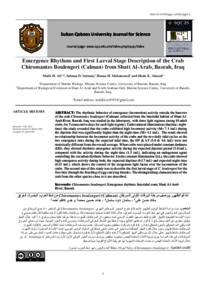وثيقة
Emergence rhythms and first larval stage description of the crab Chiromantes boulengeri (Calman) from Shatt Al-Arab, Basrah, Iraq.
المعرف
DOI:10.53539/squjs.vol29iss3pp1-6
المصدر
Sultan Qaboos University Journal for Science, v. 29, no. 3, p. 1-6.
المساهمون
عناوين أخرى
تناغم الظهور ووصف مرحلة اليرقات الأولى للسرطان Chiromantes boulengeri (Calman) من شط العرب، البصرة، العراق.
الدولة
Oman
مكان النشر
Muscat
الناشر
College of Science, Sultan Qaboos University.
ميلادي
2024
اللغة
الأنجليزية
الموضوع
الملخص الإنجليزي
The rhythmic behavior of emergence (locomotion) activity outside the burrows of the crab Chiromantes boulengeri (Calman) collected from the intertidal habitat of Shatt Al-Arab River, Basrah, Iraq, was studied in the laboratory, with three light regimes (using 10 adult crabs, for 5 consecutive days for each light regime). Under natural illumination (daytime: night-time), the study revealed that the crabs exhibited high locomotor activity (M= 7.1 ind.) during the daytime that was significantly higher than the night-time (M= 4.1 ind.). The result showed no relationship between the locomotor activity of the crabs and the two daily tidal cycles. When crabs were placed under constant darkness (DD), they showed rhythmic emergence activity during the expected daytime period, indicating an endogenous agent controlling the circadian rhythmic behavior. Under constant illumination (LL), the crabs showed high emergence activity during both the expected daytime and night-time, which shows the control of the exogenous light factor over their locomotion. Additionally, the study described, for the first time, the first larval stage of this species through laboratory hatching and rearing of egg-carrying females.
ISSN
2075-0528
الملخص العربي
تمت دراسة النشاط الرتيب للظهور (الحركة) خارج الجحور للسرطان النهري Chiromantes boulengeri (Calman) الذي جمع من الموائل بين المد والجزر في نهر شط العرب، البصرة، العراق، في المختبر تحت ثلاثة أنظمة ضوئية (باستخدام 10 سرطانات بالغة لفترة 5 أيام متتالية لكل نظام ضوئي). تحت الإضاءة الطبيعية (النهار: الليل) كشفت الدراسة أن السرطانات أظهرت نشاطًا حركيًا عاليًا (بمعدل 7.1 فرد) خلال النهار وكان أعلى بشكل ملحوظ مقارنة بالنشاط الليلي (بمعدل 4.1 فرد). لم تظهر النتائج وجود علاقة بين النشاط الحركي للسرطانات ودورات المد والجزر اليومية. أظهرت السرطانات نشاط ظهور رتيب خلال فترة النهار المتوقعة تحت الظلام المستمر (DD)، مما يشير إلى عامل داخلي يتحكم في السلوك الرتيب اليومي. تحت الإضاءة المستمرة (LL)، أظهرت السرطانات نشاطًا عاليًا خلال كل من وقتي النهار والليل المتوقعين، مما يدل على تأثير عامل الضوء الخارجي على حركتها. كما تضمنت الدراسة وصفًا لأول مرة لمرحلة اليرقات الأولى لهذا النوع من خلال تربية الإناث الحاملة للبيض في المختبر.
قالب العنصر
مقالات الدوريات

